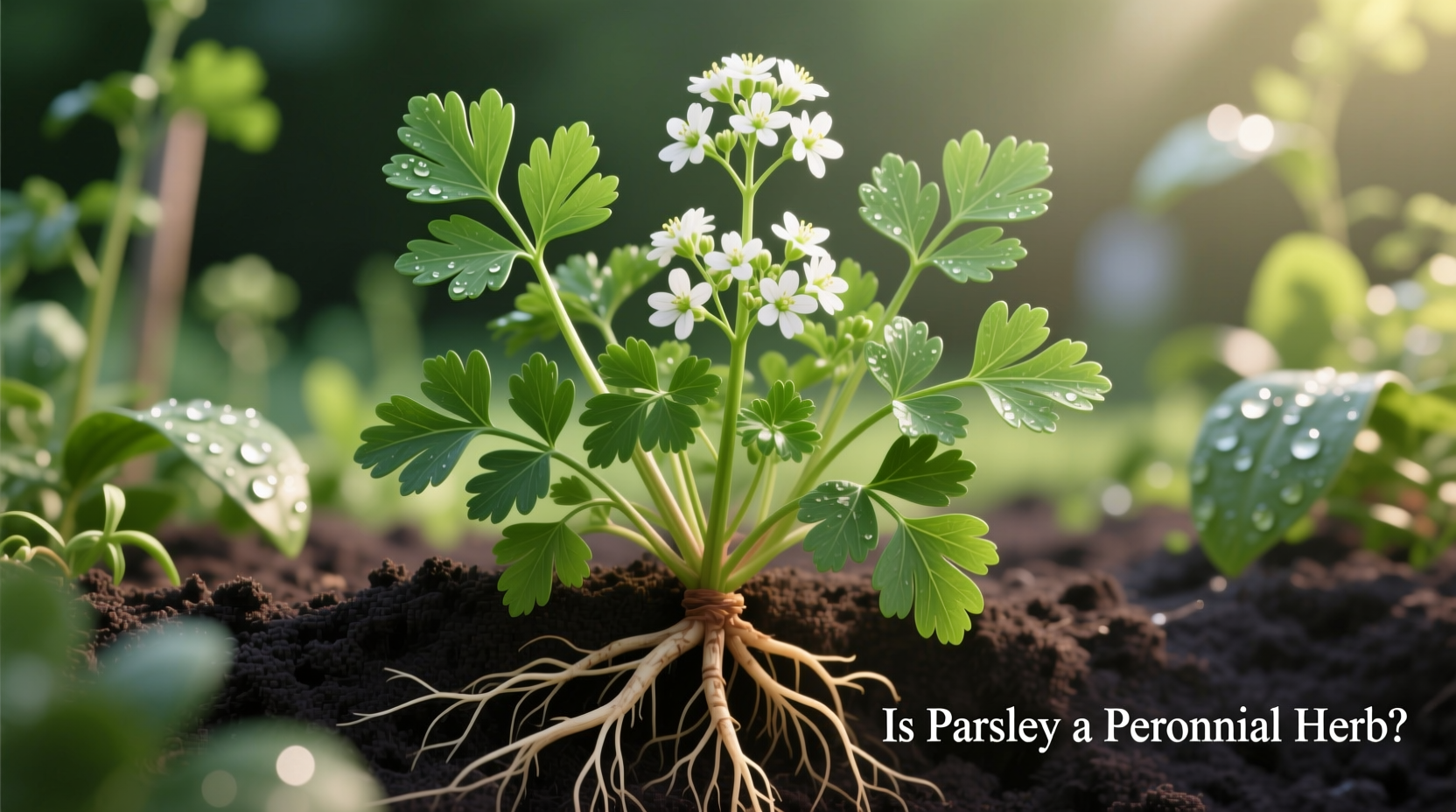Yes, parsley is technically a biennial herb, not a true perennial. While often treated as an annual in home gardens, it completes its life cycle over two years—producing lush foliage in year one and flowering/seeding in year two before dying. This distinction is crucial for gardeners planning long-term herb beds.
Understanding parsley's lifecycle helps you maximize harvests and garden planning. Unlike true perennials like rosemary or thyme that return reliably each spring, parsley's biennial nature means it requires specific care strategies to extend its productivity. Let's explore what this means for your garden.
What Does "Biennial" Really Mean for Your Parsley?
Many gardeners mistakenly classify parsley as perennial due to its hardy appearance and multi-season potential in mild climates. However, botanically speaking, Petroselinum crispum follows a strict two-year pattern:
| Plant Type | Lifecycle Duration | Parsley Example | Common Garden Examples |
|---|---|---|---|
| Annual | One growing season | N/A | Basil, cilantro, dill |
| Biennial | Two growing seasons | Year 1: Leaf production Year 2: Flowering & seeding |
Parsley, caraway, celery |
| Perennial | Three+ years | N/A | Rosemary, mint, thyme, oregano |
This classification comes from the USDA Agricultural Research Service's official plant database, which documents parsley's biennial growth habit across various climate conditions.
Your Season-by-Season Parsley Growing Guide
Knowing parsley's true nature transforms how you approach cultivation. Here's what happens each year:
Year One: The Productive Phase
During its first growing season, parsley focuses entirely on leaf production. This is when you'll get the most abundant harvests for cooking. The plant develops a strong taproot and lush foliage that can be harvested continuously. In USDA zones 7 and warmer, parsley often survives winter and returns in spring.
Year Two: The Reproductive Phase
When temperatures warm in the second spring, parsley shifts energy to flowering and seed production. The leaves become bitter and less desirable for culinary use. While some gardeners try to prevent bolting by cutting flower stalks, the plant's biological imperative makes this only temporarily effective.

Maximizing Your Parsley Harvest: Practical Strategies
While you can't change parsley's biological nature, these techniques help extend its usefulness:
Succession Planting for Continuous Supply
Plant new seeds every 3-4 weeks during the growing season. This ensures you always have first-year plants at their peak. The University of Minnesota Extension recommends this approach for reliable harvests throughout the season.
Winter Protection Methods
In zones 6 and colder, protect plants with:
- 3-4 inches of mulch after first frost
- Cold frames for extended harvest
- Container growing with indoor winter transition
According to Cornell University's Gardening Resources, these methods can help first-year plants survive winter and provide early spring harvests before they bolt.
Common Misconceptions About Parsley's Lifecycle
Many gardeners operate under incorrect assumptions that lead to disappointment:
- "Parsley is perennial in all climates" - While it may survive mild winters, it still completes its lifecycle after two years
- "Cutting flowers will keep it productive" - Temporary solution; the plant will eventually bolt regardless
- "All parsley varieties behave the same" - Hamburg root parsley has different growth patterns than leaf varieties
When Parsley Acts Like a Perennial (And Why)
In USDA zones 8-10, parsley often behaves like a perennial because mild winters allow first-year plants to survive and continue growing. However, these plants still follow the biennial pattern—they'll eventually flower and die after two years. The Royal Horticultural Society notes this apparent perennial behavior in Mediterranean climates where winter temperatures rarely drop below 20°F (-7°C).
Planning Your Herb Garden: Where Parsley Fits In
Understanding parsley's true nature helps you design more efficient garden layouts:
- Place near annual vegetables for easy rotation
- Avoid permanent perennial beds where space is limited
- Consider container growing for better lifecycle management
- Pair with compatible herbs like chives and cilantro that share similar water needs
Harvesting Techniques That Extend Productivity
Maximize your harvest window with these methods:
- Always harvest outer stems first, encouraging new growth from the center
- Never remove more than one-third of the plant at once
- Morning harvesting yields the most flavorful leaves
- Regular trimming delays (but doesn't prevent) bolting
These techniques, documented in the University of Georgia Cooperative Extension publications, help maintain plant health throughout its productive phase.
When to Replace Your Parsley Plants
Watch for these signs that it's time to start anew:
- Flower stalks emerging from the center
- Noticeable bitterness in the leaves
- Reduced new growth despite proper care
- Second spring growth after overwintering
Attempting to keep second-year plants often wastes garden space better used for new seedlings. The National Gardening Association recommends treating parsley as a semi-perennial—expecting 18-24 months of productivity with proper care before replacement.











 浙公网安备
33010002000092号
浙公网安备
33010002000092号 浙B2-20120091-4
浙B2-20120091-4